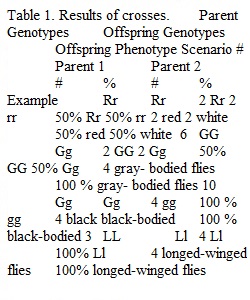


Q How to Proceed • Read through the introductory materials below. • Open the Unit 6 Experiment Answer Sheet and complete the following Experiment exercises this unit: o Experiment 6 Exercise 1 - Monohybrid crosses (~45 min) o Experiment 6 Exercise 2 - Dihybrid crosses (~30 min) o Experiment 6 Exercise 3 - Inheritance of Human Traits (~30 min) • Save your completed Unit 6 Experiment Answer Sheet and submit it no later than Sunday midnight (CT). ________________________________________ Monhybrid and Dihybrid Crosses - Introduction Mendel crossed true-breeding pea plants in order to develop and understanding of how traits are inherited. True-breeding means that if a plant was crossed with itself, it always generated offspring that looked like the parent. Although Mendel didn’t know this at the time, it meant that the parent plant was homozygous or had two copies of the same allele that controlled the appearance of the trait. Mendel noticed that when he crossed two true-breeding plants exhibiting different versions of a trait (e.g., green and yellow); the offspring (F1) always looked like only one of the parent plants. We know now that the F1 individuals looked like the parent that carried the dominant trait. But what surprised Mendel, was that when he crossed the F1 individuals with each other, the F2 offspring exhibited BOTH traits! Based on this observation, he concluded that the F1 individuals were hybrids, meaning they carried both alleles for a given trait. Only the dominant trait was expressed in the F1 individuals and the recessive trait, although present, was masked. A monohybrid cross is when you are interested in crossing individuals that vary in only a single trait (e.g., flower color, seed color, stem length). In a dihybrid cross, we are crossing individuals that differ at two traits (e.g., flower color and seed color, flower color and stem length). Obviously, the more traits that vary, the more complex the crosses become! By examining the distribution of the various traits obtained following different types of crosses, Mendel was able to describe the general pattern of genetic inheritance. Be sure to review the online lecture this unit on Genetics and pp 146-153 in your book before starting these first two exercises. We will be using the following website for the first exercise. Be sure that you can access it and use it before beginning: Fly Lab JS (Links to an external site.) You will need to complete the Tables and answer the questions in the Unit 6 Experiment Answer Sheet for Exercises 1 and 2. ________________________________________ Inheritance of Human Traits - Introduction Some human traits are controlled by a single gene that has only two alternative alleles. If a characteristic is determined by the dominant allele, one or both parents express that trait and many of the children will as well. Dominant characteristics will most likely be present in every generation, since the expression of these traits requires only one of the dominant alleles in order to be expressed. If the characteristic is determined by the recessive allele, then neither parent may express the trait nor few of the children. This is because two copies of the recessive allele must be present in order for the recessive trait to be expressed. If a trait is X-linked recessive; meaning the gene for the trait is found on the X chromosome, it will be expressed primarily in males. The application of human genotypes in medicine and genetic counseling is becoming more and more necessary as we discover more about the human genome. Despite our increasing ability to decipher the chromosomes and their genes, an accurate family history remains one of the best sources of information concerning the individual. In this exercise you will determine your genotype for certain characteristics that are controlled by a single gene with two alleles based on your phenotype. We will not be looking at any X-linked traits in this exercise. Use the information about the traits of interest in the Unit 6 Experiment Answer Sheet to answer the questions found there. ________________________________________ Unit 6 Experiment Grading Rubric Component Expectation Points Experiment 6 Exercise 1 Correctly perform and record the outcome of five monohybrid crosses (Table 1). 5 pts Demonstrate an understanding of the possible outcomes of monohybrid crosses with respect to genotypes and phenotypes (Questions 1-2). 5 pts Experiment 6 Exercise 2 Determine the correct parental gametes and conduct a dihybrid cross. (Table 1). 5 pts Correctly evaluate the outcome of a dihybrid cross (Questions 1-2). 6 pts Experiment 6 Exercise 3 Correctly recognize one’s phenotype and assigns the correct genotype (Table 2). 8 pts Demonstrate an understanding of dominant and recessive traits, genotype vs phenotype and homozygous vs heterozygous (Questions 1-6). 6 pts TOTAL [[[[[[[ 35 pts
View Related Questions